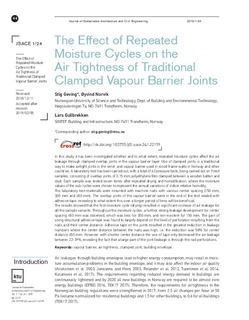| dc.description.abstract | In this study it has been investigated whether and to what extent, repeated moisture cycles affect the airleakage through clamped overlap joints in the vapour barrier layer. Use of clamped joints is a traditionalway to make airtight joints in the wind- and vapour barrier used in wood frame walls in Norway and othercountries. A laboratory test has been carried out, with a total of 63 pressure tests, being carried out on 9 testsamples, consisting of overlap joints of 0.15 mm polyethylene film clamped between a wooden batten andstud. Each sample was tested seven times after repeated drying and humidification, where the moisturevalues of the sub-cycles were chosen to represent the annual variations of indoor relative humidity.The laboratory test materials were mounted with machine nails with various center spacing (150 mm,300 mm and 450 mm). The overlap joints of the vapour barrier were in the end of the test sealed withadhesive tape, revealing to what extent this over a longer period of time will be beneficial.The results showed that the first moisture cycle (drying) resulted in significant increase of air leakage forall the sample variants. Throughout the moisture cycles, a further strong leakage development for centerspacing 450 mm was observed, which was less for 300 mm, and non-existent for 150 mm. The gain ofusing structural adhesive tape was found to largely depend on the level of perforation resulting from thenails and their center distance. Adhesive tape on the joints resulted in the greatest reduction in leakage numbers where the center distance between the nails was high, i.e. the reduction was 58% for center distance 450 mm. However, with shorter center distance the use of tape only decreased the air leakage between 22-39%, revealing the fact that a large part of the joint leakage is through the nail perforations. | nb_NO |
